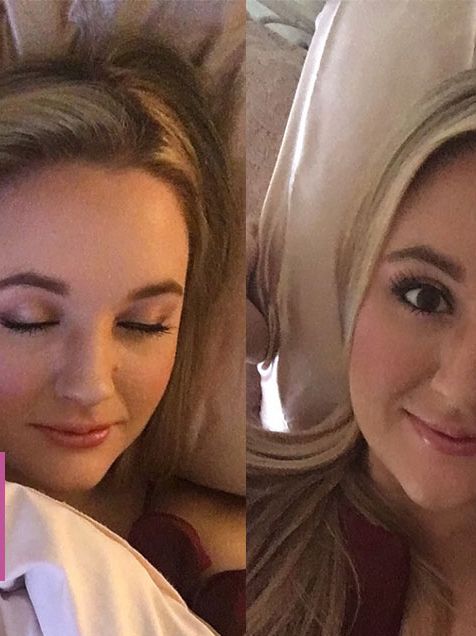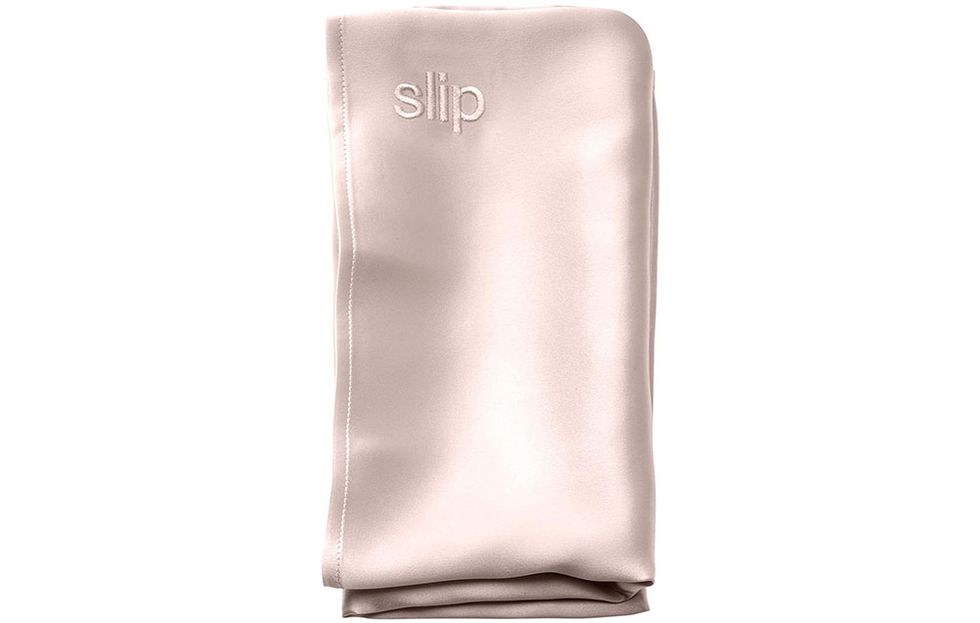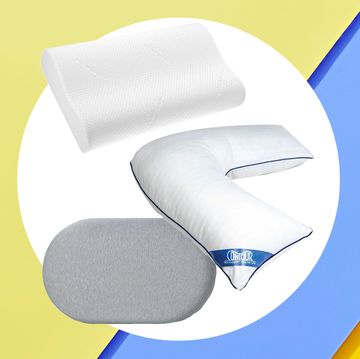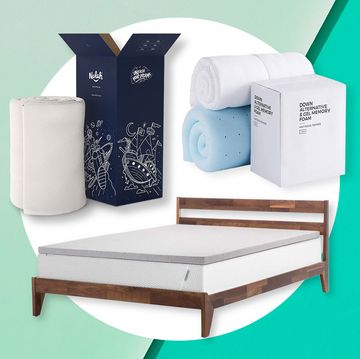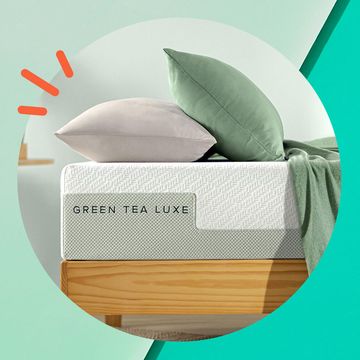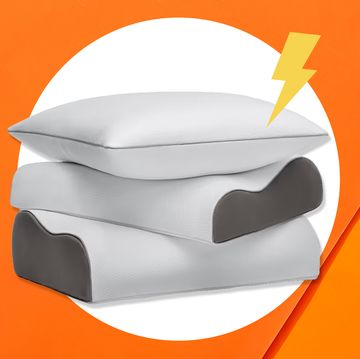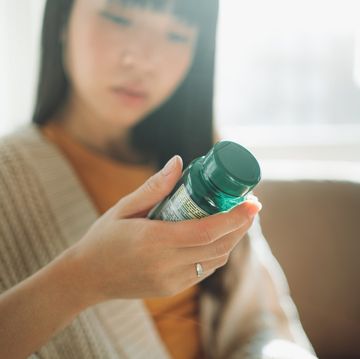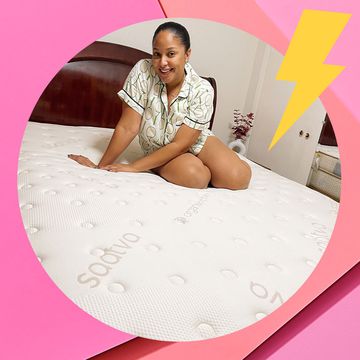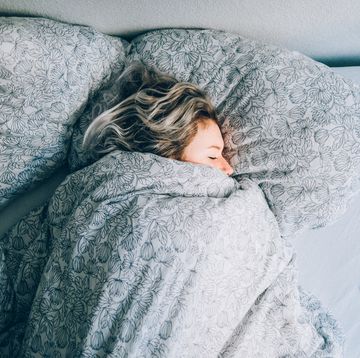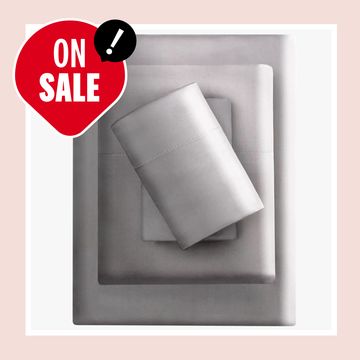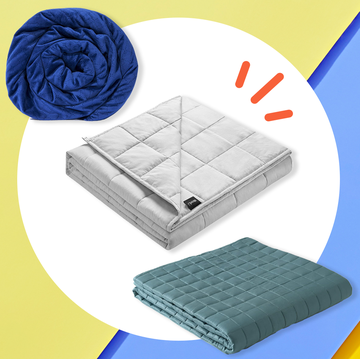Back in college, I was (and still am) best friends with a girl who had an almost baby blanket-like obsession with her silk pillowcase. Not only did she use it every night in the dorms, she'd bring it with her on dates and on spring break tips. And on those nights when she’d forget it—and we’d be backtracking in a cab to retrieve it—I’d mercilessly tease her. It’s a freaking pillow, girl.
So imagine my surprise when years later, silk pillowcases started getting all kinds of love in the beauty world (even from celebs like Kourtney Kardashian) for being a skin- and hair-care necessity. Unless my pillowcase was swabbed with argan oil, what effect could it possibly have on my skin and hair?
A fairly sizable one, says Gary Goldenberg, M.D., of Goldenberg Dermatology in NYC. “Silk, like cotton or wool, is a natural fabric. Natural fabrics are simply better for your skin, especially for those with sensitive skin or eczema,” he explains. “Patients with acne or acne-prone skin may benefit from high-quality silk since it doesn’t clog pores.”
Andre Walker, celebrity hair stylist and co-founder of Andre Walker Hair, shares that sentiment. "Standard cotton cases are known to cause breakage and split ends," Walker says, and because cotton is such an absorbent fabric, he says it can sap your hair of moisture. “Silk pillowcases help to maintain your style, in addition to keeping your curls and coils from frizzing and straightening out," he says. Because the fabric is smooth and absorbent, it causes less friction against your hair, helping your blowout last longer and reducing breakage.
Smushing her face in silk each night would seem like a no-brainer for someone as extra as Kourtney Kardashian... so the pragmatist in me was skeptical. The inquisitive beauty writer in me, on the other hand was insanely curious. So I decided to nab the most popular silk pillowcase on the market—the Slip Silk Pillowcase ($79, nordstrom.com)—and test it out for two weeks, observing the effect it had on my hair and skin along the way.
Sleep #1: Did I Just Sleep For 8 Hours?
The second I lay my head atop the Slip Silk Pillowcase, the temperature dip (in comparison to my previous cotton-based pillowcase) was dramatic. I run naturally hot and crave ultra-cool sleeping environments, so I fell into a slumber—that lasted a full eight hours—almost instantly. (Is this how it feels to be a rested royal?)
Although my budding forehead wrinkle and large pores were as noticeable as ever sans makeup, I didn’t a.) have an impression of a pillow crease on my cheek, or b.) look entirely rundown. Despite the fact that I didn’t wake up with any less pimples after my first night sleeping on a silk pillowcase, I still felt (and looked) more rested and refreshed than usual, especially during the work week.
But, as Goldenberg emphasizes, the skin results from sleeping on a silk pillowcase don’t happen (quite literally) overnight. “For those with sensitive skin or eczema that are switching from a synthetic fabric, results should be almost instant," he says. "For those with acne or acne-prone skin, it may take a month to see fewer breakouts.”
RELATED: 13 Silk Pillowcases That Fight Wrinkles And Bed Head
Sleep #2 - #5: Where Are My Red Splotches?
By my third or fourth night sleeping on my blush-colored silk pillowcase (aside from feeling like a total Crown cast member) I began to notice more distinct changes in the mirror when checking my mug each morning.
As I’ve mentioned in previous stories on Women's Health, my complexion is a cream-colored Monet painting...there’s always some new allergen causing it to flare without warning, and that’s usually most apparent in the morning. However, my trademark splotchy red complexion was significantly toned down in the morning after a few nights of sleeping on my silk pillowcase.
Similarly, my hair seemed to appear less tangled. While that could certainly be a product of my more undisturbed, ultra-cool sleep, Walker says that the silk plays a role. “When sleeping on a silk pillowcase, your hair slides over the satin texture of the fabric, pushing your strands away from the pressure of your head,” he explains. “It also protects your hair from potentially getting caught and breaking in the weave of the fabric."
Your Body Might Be Sabotaging Your Sleep—Here’s How To Fix It:
Sleep #6 - #14: Am I Basically A Kardashian Now Or...?
Midway through my two week-long experiment sleeping on a silk pillowcase, I was hooked. But that adoration didn’t necessarily stem from the slight skin or hair benefits I was seeing. After all, I have creams, serums, and masks I think do a far better job of fighting my acne-ridden complexion and frizzy hair. It seems that the silk pillowcase is not a beauty cure-all, but rather a nice addition to help make your existing routines and treatments work a little bit better.
RELATED: 8 Ways To Turn Off Your Brain So You Can Actually Sleep At Night
That's not to say this pillowcase isn't worth it. To me, the biggest benefits were the added luxury in my routine, the cooler, more restful sleep, and (dare I say?) sexiness and sensuality of sleeping on silk—three components it seems my pillow-toting BFF since college knew all along. And I've never slept better.
The only downside (if you can even call it that) was that, on those nights I’d apply heavy sleeping creams and masks, I’d feel my cheek stick slightly to the pillow. The case is also on the expensive side, but to me, it seemed well worth the splurge for a cooler, more restful night's sleep. (Plus, Slip Silk came out with a more affordable alternative last year—The Hollywood Silk Solution—which has a silk top and a cotton underside for $45).
After feeling (rather than necessarily seeing) the effects of sleeping on a silk pillowcase, it's safe to say I won't be parting with my pink-and-cream-colored cloud anytime soon. Toting it along on my next Tinder date probably isn't out of the realm possibility either.

